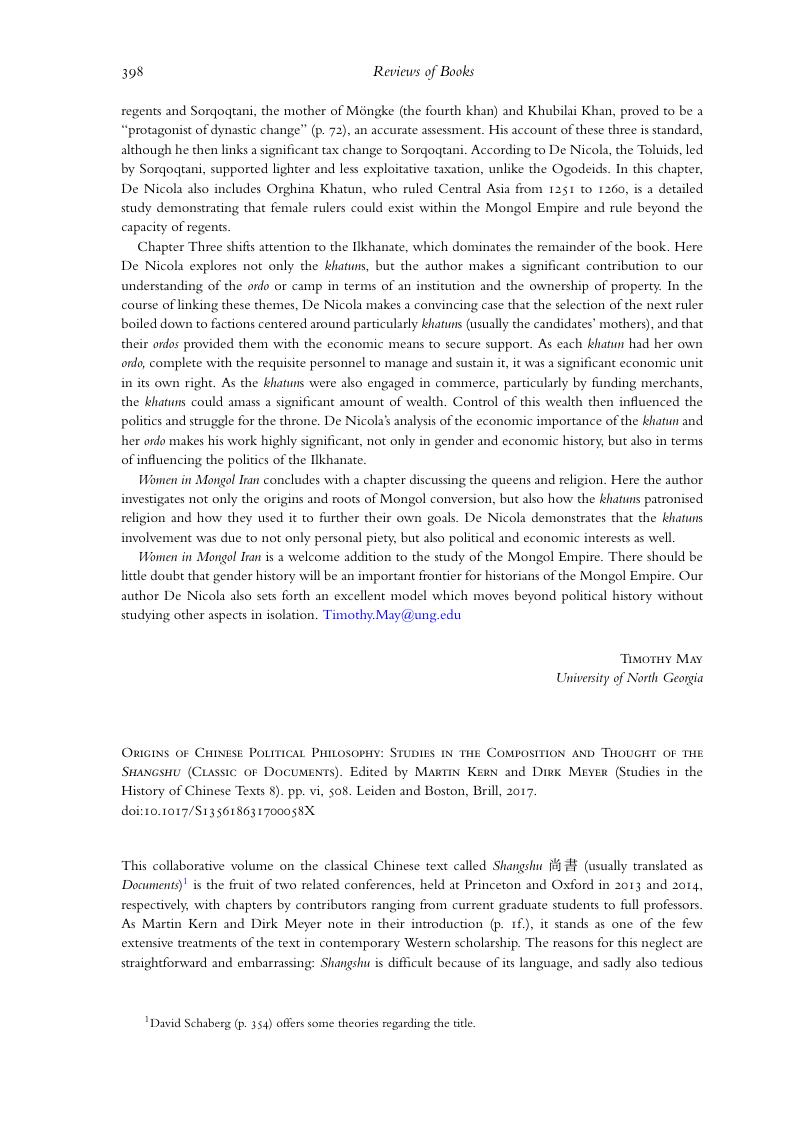Published online by Cambridge University Press: 16 November 2017

1 David Schaberg (p. 354) offers some theories regarding the title.
2 In the interest of full disclosure, I should state that this is why I dropped out of the project after attending the first conference at Princeton.
3 For my reasons, see “Heng xian and the Problem of Studying Looted Artifacts,” Dao 12.2 (2013), pp. 153-160.
4 Shangshu zongshu 尚書綜述 (Shanghai, 1988), p. 133.
5 A previous version was published in Ideology of Power and Power of Ideology in Early China, (ed.) Y. Pines et al. (Leiden, 2015), pp. 118-151.
6 In the so-called guwen 古文 edition of the text, the two parts are divided into separate chapters: “Yao dian” and “Shun dian” 舜典.
7 One distinction: whereas Kern explains the differences between the two sections as a matter of chronology—a new model of kingship against the backdrop of an older one—Vogelsang entertains the possibility they derive from different parts of China (Chu 楚 and Qin) before conceding that the evidence is inconclusive (pp. 100-103).
8 My one misgiving is that shi does not ordinarily bear this sense, and in any case “harangue” has varying connotations in English, many of which are pejorative. The normal meaning of shi is “oath,” as Maria Khayutina points out later in the book, adding: “It is possible, though not yet supported by Western Zhou epigraphic evidence, that legally binding oaths were taken in military contexts” (“‘Bi shi’ 費誓, Western Zhou Oath Texts, and the Legal Culture of Early China,” p. 426). She also notes, provocatively, that shi “could be enforced in response to an overlord's command (ming 命)” (p. 427). My theory would be that if the operative “command” in the Shangshu was construed as “Heaven's command” (tianming 天命, i.e. the divine right to rule), then the kings’ famous battlefield speeches were to be understood as their “oaths” to carry out this formidable charge.
9 Presumably Dirk Meyer means something similar when he characterizes “Gu ming” 顧命 as “lieu de mémoire” (“Recontextualization and Memory Production: Debates on Rulership as Reconstructed from ‘Gu ming’ 顧命,” p. 127), but he does not elaborate on his understanding of this concept (which is borrowed from Pierre Nora).
10 Kern expects his learned readers to know that the terminology is from Genette, Gérard, e.g., Palimpsests: Literature in the Second Degree, translated by Newman, C. and Doubinsky, C. (Lincoln, Nebraska, 1997), p. 5.Google Scholar I would add that the antecedent of a “harangue” need not have been textual at all: it might simply have been a shared notion that venerable kings exhorted their troops before winning an epoch-making battle.
11 For a recent study in English, see McNeal, R., Conquer and Govern: Early Chinese Military Texts from the Yi Zhou shu (Honolulu, 2012), pp. 73–96CrossRefGoogle Scholar; also Shaughnessy, E. L., Rewriting Early Chinese Texts (Albany, N.Y., 2006), pp. 178ff.Google Scholar
12 Grebnev was not aware of a relevant publication that has appeared in the interim: He, R. and Nylan, M., “On a Han-Era Postface (xu 序) to the Documents,” Harvard Journal of Asiatic Studies 75.2 (2016), pp. 377–426CrossRefGoogle Scholar. Moreover, he might have commented on the similarity of the programme of systematically historicising the chapters of Shangshu to the so-called “minor prefaces” (xiaoxu 小序) attached to each item in the Mao Shi 毛詩 (Mao Odes), which do nearly the same thing. See, e.g., Mao Xuanguo 毛宣國, “Handai Shijing lishihua jiedu de shixue yiyi” 漢代《詩經》歷史化解讀的詩學意義, Wenxue pinglun 文學評論 2007.3, pp. 169-174.
13 Schaberg says “lunar lodges”, but “lodges” is more precise. See Cullen, C., “Translating 宿 *sukh/xiu and 舍 *lhah/she—‘Lunar Lodges’ or Just Plain ‘Lodges’?” East Asian Science, Technology and Medicine 33 (2011), pp. 84–95.Google Scholar
14 Before Confucius: Studies in the Creation of the Chinese Classics (Albany, N.Y., 1997), especially pp. 114-118.
15 Not coincidentally, Shaughnessy has published prominently on this text too: Before Confucius, pp. 31-67.
16 See, e.g., Nivison, D.S., The Ways of Confucianism: Investigations in Chinese Philosophy, (ed.) Van Norden, B.W. (Chicago and LaSalle, Ill., 1996), pp. 226–228.Google Scholar